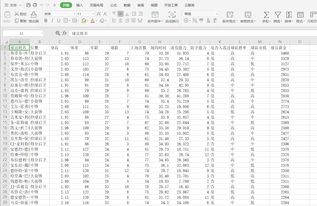小波逆变换c语言代码(小波变换函数)
admin 发布:2022-12-19 20:36 99
今天给各位分享小波逆变换c语言代码的知识,其中也会对小波变换函数进行解释,如果能碰巧解决你现在面临的问题,别忘了关注本站,现在开始吧!
本文目录一览:
C语言怎么实现小波变换
#include stdio.h
#include stdlib.h
#define LENGTH 512//信号长度
/******************************************************************
* 一维卷积函数
*
* 说明: 循环卷积,卷积结果的长度与输入信号的长度相同
*
* 输入参数: data[],输入信号; core[],卷积核; cov[],卷积结果;
* n,输入信号长度; m,卷积核长度.
*
* 李承宇, lichengyu2345@126.com
*
* 2010-08-18
******************************************************************/
void Covlution(double data[], double core[], double cov[], int n, int m)
{
int i = 0;
int j = 0;
int k = 0;
//将cov[]清零
for(i = 0; i n; i++)
{
cov[i] = 0;
}
//前m/2+1行
i = 0;
for(j = 0; j m/2; j++, i++)
{
for(k = m/2-j; k m; k++ )
{
cov[i] += data[k-(m/2-j)] * core[k];//k针对core[k]
}
for(k = n-m/2+j; k n; k++ )
{
cov[i] += data[k] * core[k-(n-m/2+j)];//k针对data[k]
}
}
//中间的n-m行
for( i = m/2; i = (n-m)+m/2; i++)
{
for( j = 0; j m; j++)
{
cov[i] += data[i-m/2+j] * core[j];
}
}
//最后m/2-1行
i = (n - m) + m/2 + 1;
for(j = 1; j m/2; j++, i++)
{
for(k = 0; k j; k++)
{
cov[i] += data[k] * core[m-j-k];//k针对data[k]
}
for(k = 0; k m-j; k++)
{
cov[i] += core[k] * data[n-(m-j)+k];//k针对core[k]
}
}
}
/******************************************************************
* 一维小波变换函数
*
* 说明: 一维小波变换,只变换一次
*
* 输入参数: input[],输入信号; output[],小波变换结果,包括尺度系数和
* 小波系数两部分; temp[],存放中间结果;h[],Daubechies小波基低通滤波器系数;
* g[],Daubechies小波基高通滤波器系数;n,输入信号长度; m,Daubechies小波基紧支集长度.
*
* 李承宇, lichengyu2345@126.com
*
* 2010-08-19
******************************************************************/
void DWT1D(double input[], double output[], double temp[], double h[],
double g[], int n, int m)
{
// double temp[LENGTH] = {0};//?????????????
int i = 0;
/*
//尺度系数和小波系数放在一起
Covlution(input, h, temp, n, m);
for(i = 0; i n; i += 2)
{
output[i] = temp[i];
}
Covlution(input, g, temp, n, m);
for(i = 1; i n; i += 2)
{
output[i] = temp[i];
}
*/
//尺度系数和小波系数分开
Covlution(input, h, temp, n, m);
for(i = 0; i n; i += 2)
{
output[i/2] = temp[i];//尺度系数
}
Covlution(input, g, temp, n, m);
for(i = 1; i n; i += 2)
{
output[n/2+i/2] = temp[i];//小波系数
}
}
void main()
{
double data[LENGTH];//输入信号
double temp[LENGTH];//中间结果
double data_output[LENGTH];//一维小波变换后的结果
int n = 0;//输入信号长度
int m = 6;//Daubechies正交小波基长度
int i = 0;
char s[32];//从txt文件中读取一行数据
static double h[] = {.332670552950, .806891509311, .459877502118, -.135011020010,
-.085441273882, .035226291882};
static double g[] = {.035226291882, .085441273882, -.135011020010, -.459877502118,
.806891509311, -.332670552950};
//读取输入信号
FILE *fp;
fp=fopen("data.txt","r");
if(fp==NULL) //如果读取失败
{
printf("错误!找不到要读取的文件/"data.txt/"/n");
exit(1);//中止程序
}
while( fgets(s, 32, fp) != NULL )//读取长度n要设置得长一点,要保证读到回车符,这样指针才会定位到下一行?回车符返回的是零值?是,非数字字符经过atoi变换都应该返回零值
{
// fscanf(fp,"%d", data[count]);//一定要有""啊!!!最后读了个回车符!适应能力不如atoi啊
data[n] = atof(s);
n++;
}
//一维小波变换
DWT1D(data, data_output, temp, h, g, n, m);
//一维小波变换后的结果写入txt文件
fp=fopen("data_output.txt","w");
//打印一维小波变换后的结果
for(i = 0; i n; i++)
{
printf("%f/n", data_output[i]);
fprintf(fp,"%f/n", data_output[i]);
}
//关闭文件
fclose(fp);
}

小波分解与合成的完整代码
% Load original 1D signal.
load leleccum; s = leleccum(1:3920);
ls = length(s);
% Perform one step decomposition of s using db1.
[ca1,cd1] = dwt(s,'db1');
% Perform one step reconstruction of ca1 and cd1.
a1 = upcoef('a',ca1,'db1',1,ls);
d1 = upcoef('d',cd1,'db1',1,ls);
% Now plot a1 + d1.
% Invert directly decomposition of s using coefficients.
a0 = idwt(ca1,cd1,'db1',ls);
% Perform decomposition at level 3 of s using db1.
[c,l] = wavedec(s,3,'db1')
% Extract approximation coefficients at level 3,
% from wavelet decomposition structure [c,l].
ca3 = appcoef(c,l,'db1',3);
% Extract detail coefficients at levels 1, 2 and 3,
% from wavelet decomposition structure [c,l].
cd3 = detcoef(c,l,3);
cd2 = detcoef(c,l,2);
cd1 = detcoef(c,l,1);
% Reconstruct approximation at level 3,
% from wavelet decomposition structure [c,l].
a3 = wrcoef('a',c,l,'db1',3);
% Reconstruct detail coefficients at levels 1,2 and 3,
% from the wavelet decomposition structure [c,l].
d3 = wrcoef('d',c,l,'db1',3);
d2 = wrcoef('d',c,l,'db1',2);
d1 = wrcoef('d',c,l,'db1',1);
% Reconstruct s from the wavelet decomposition structure [c,l].
a0 = waverec(c,l,'db1');
小波变换
我给你大概标注了一下,但是你的程序有问题,
% 小波图像压缩 - RGB 图像
clear all;
close all;
% 读取图像
im = input('输入图像');%输入图像名称,要加分号
X=imread(im);
% 输入要分解的小波层数和小波
n=input('输入要分解的小波层数');%输入所要分解的层数
wname = input('输入小波名称');%输入小波名称,也要加分号
x = double(X);
NbColors = 255;
map = gray(NbColors);
x = uint8(x);
%把RGB图像转换成灰度图
% x = double(X);
% xrgb = 0.2990*x(:,:,1) + 0.5870*x(:,:,2) + 0.1140*x(:,:,3);
% colors = 255;
% x = wcodemat(xrgb,colors);
% map = pink(colors);
% x = uint8(x);
% 对图像x进行n维小波分解
[c,s] = wavedec2(x,n,wname);
% 使用默认参数选择各层不同的阈值
alpha = 1.5; m = 2.7*prod(s(1,:));
[thr,nkeep] = wdcbm2(c,s,alpha,m)
% 使用上面的阈值和硬阈值处理进行图像压缩
[xd,cxd,sxd,perf0,perfl2] = wdencmp('lvd',c,s,wname,n,thr,'h');
disp('压缩效率');
disp(perf0);
% 重构(下面这个地方有问题,你这里是原始图像小波变换后进行重构,xd才是小波阀值压缩后重构的图像,cxd,sxd,是c,s经过阀值处理后得到的小波分解结构,也就是说xd=waverec2(cxd,sxd,wname);这个wdencmp函数不需要另外进行重构,你下面那些关于重构的都没用,而下面压缩后的图像才是重构后的图像,)
R = waverec2(c,s,wname);
rc = uint8(R);
% 显示原始图像和压缩图像
subplot(221), image(x);
colormap(map);
title('原始图像')
subplot(222), image(xd);
colormap(map);
title('压缩后的图像')
% 显示结果
xlab1 = ['图像压缩后保留能量百分比',num2str(perfl2)];
xlab2 = ['小波阀值压缩后置零系数百分比 ',num2str(perf0), ' %'];
xlabel([xlab1 xlab2]);
subplot(223), image(rc);
colormap(map);
title('重构图像');
%计算图像大小
disp('原始图像');
imwrite(x,'original.tif');%将图像x保存为original.tif,下同
imfinfo('original.tif')%显示图片original.tif详细信息,下同
disp('压缩后的图像');
imwrite(xd,'compressed.tif');
imfinfo('compressed.tif')
disp('重构后的图像');
imwrite(rc,'decompressed.tif');
imfinfo('decompressed.tif')
如何用C语言实现小波多层变换wavedec2
C语言标准库当中没有这种函数,去OpenCV库当中找找有没有类似函数,如果自己实现想是相当麻烦
小波逆变换c语言代码的介绍就聊到这里吧,感谢你花时间阅读本站内容,更多关于小波变换函数、小波逆变换c语言代码的信息别忘了在本站进行查找喔。
版权说明:如非注明,本站文章均为 AH站长 原创,转载请注明出处和附带本文链接;
相关推荐
- 05-12网页设计需要学什么,网页设计学什么语言
- 05-09网页代码,网页代码快捷键
- 05-06单页网站的代码(完整的网页代码)[20240506更新]
- 05-06个人主页图片代码(个人主页图片代码怎么弄)[20240506更新]
- 05-06提取微信名片代码(微信名片信息提取)[20240506更新]
- 05-06php后台权限管理代码(php管理员权限)[20240506更新]
- 05-06付费观看代码php(付费观看代码)[20240506更新]
- 05-06在线html执行代码(html怎么运行)[20240506更新]
- 05-06源代码管理资源管理器(资源管理器运行代码)[20240506更新]
- 05-06代码源软件库(程序代码库)[20240506更新]
取消回复欢迎 你 发表评论:
- 标签列表
- 最近发表
- 友情链接


